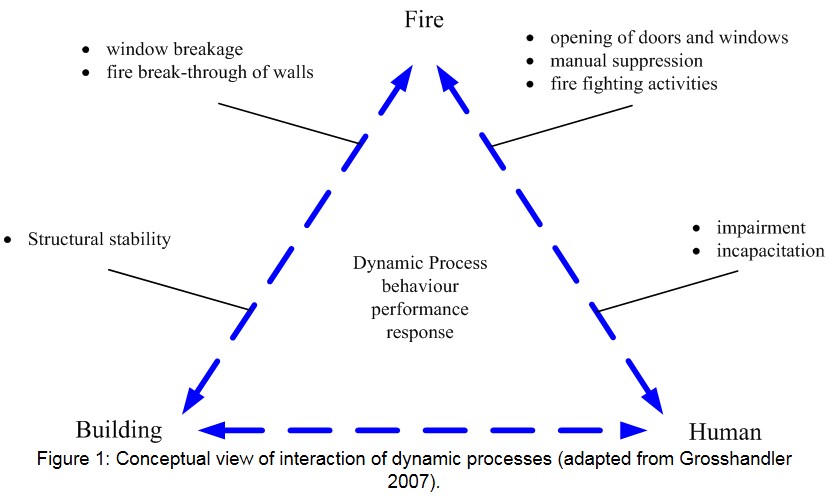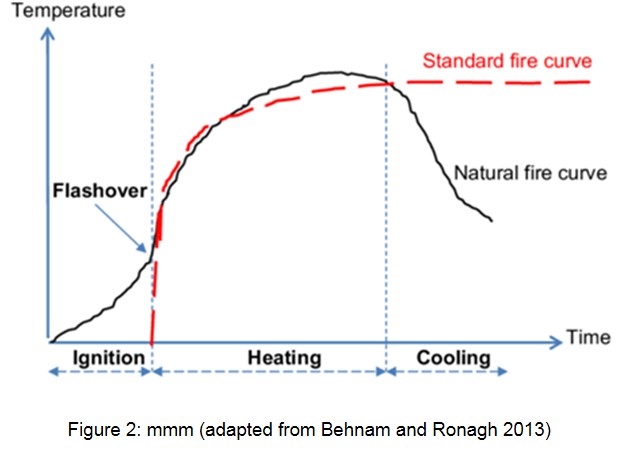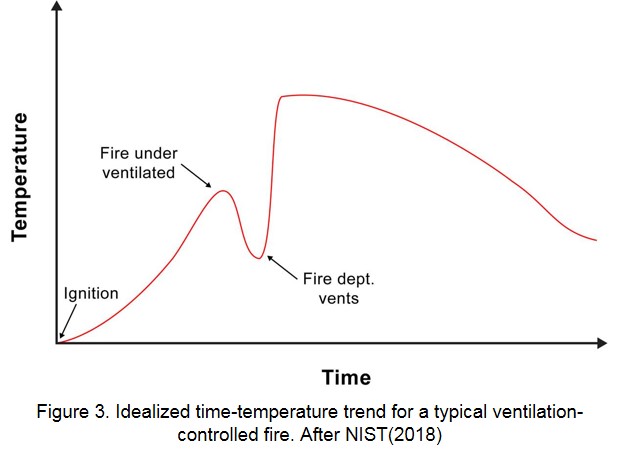Introduction
Fire hazard analysis (FHA) is aimed at the definition reliable fire scenarios and fire intensity measures (IMs), and their probability of occurring during a reference time span (e.g. one year or the life-cycle of a considered structure).
Since fire hazard is directly related to the presence of flammable material, as already introduced for earthquakes, it turns out to be influenced by exposure, i.e. intended uses, in that the reference building assumed as target drives the choice of the analysis approach and assumptions on the characteristic fire considered.
As a general consideration, it is important to highlight (also at the hazard analysis step) that, although often the main focus is towards to the direct consequences of fire, the indirect consequences of a fire are even more important. Direct consequences include structural damage and even structural collapse, while indirect consequences are those due to oxygen consumption by the fire that may lead to the asphyxiation of the nearby people (since fire consumes the oxygen in the air, thereby increasing the concentration of deadly carbon monoxide in the atmosphere). In this view, the FHA should be intended to focus on quantify the hazards and risk of fire and its indirect effects on people (Buchannan 2017).
Then, the correct quantification of the fire hazard require a very good understanding of the fire phenomenon. One important aspect is the understanding of the interactions between building, fire and human dynamics, and their role in the fire severity and intensity (Grosshandler 2007). For example, due to onset of suffocation symptoms, people can be forced of opening windows in a close room under fire attack, this can generate a surge in fire intensity due to the additional oxygen entering the room from opened windows. On the other side, humans can react rapidly to fire (Lougheed and Hadjisophocleous 2011) and generate alarms which are able to starts mitigation measures (e.g. manual splinkers’ activation) which are able to decrease the fire intensity. All these human-hazard interactions (schematized in Figure 1) are not present in other hazard (e.g. earthquakes).

In order to understand basic phenomena involved in fire developments for structural engineering purposes, the general development of the room temperature in a compartment under fire can be described by the Temperature-time (T-t) idealized curve shown in Figure 2.

The idealized curve shows that the fire begins with ignition, it is then in the growth phase, where the heat-release rate increases until the fire is fully developed, after sometimes necessary for burning main combustible available, the temperature in the environment starts decreasing (cooling phase) due to the lack of combustible. In a compartment fire (contained environment), the transition from the growth stage to the fully developed stage involves a particular transition stage called flashover. In flashover, surfaces exposed to thermal radiation from fire gases in excess of 600°C reach ignition temperature more or less simultaneously. Fire spreads very rapidly through the compartment, with burning from floor to ceiling. Without an intervention before the flashover point, the fire is rarely (almost impossibly) to be extinguished by firefighters or splinkers. Before the flashover occurs, the fire is called “ventilation-controlled” since it is assumed to be developed in a compartment with sufficient combustible to develop the flashover, and its growing is temporally governed by the availability of oxygen in the department (if oxygen is not sufficient fire decays). From flashover on, fire becomes “fuel-controlled”, meaning that the amount of oxygen needed to sustain the heat-generating chemical reaction with all the combustible material in the compartment. In such cases, the peak temperature and peak heat-release rate is limited by the amount of available combustible material, and the decay stage is typically related to the reduced amount of fuel available for burning. In the same Figure 2, the ISO fire design curve (ISO 1999a,b , EN 1990) is shown; this is the standard T-t curve used in structural design for fire, where pre-flashover and cooling phases are neglected since they are not relevant for the evaluation of the maximum structural resistance to fire action.
In order to better understand the above-mentioned human-fire interaction, we can focus on the time history of a ventilation limited fire (Figure 3). Fire development is taken from NIST (2018, https://www.nist.gov/%3Cfront%3E/fire-dynamics): “in this case the fire starts in a compartment with doors and windows closed. Early in the fire growth stage there is adequate oxygen to mix with the heated gases, which results in flaming combustion. As the oxygen level within the structure is depleted, the fire decays, the heat release from the fire decreases and as a result the temperature decreases. When a vent is opened, such as when the fire department enters a door, oxygen is introduced. The oxygen mixes with the heated gases in the structure and the energy level begins to increase. This change in ventilation can result in a rapid increase in fire growth potentially leading to a flashover (fully developed compartment fire) condition”.
By relying on the T-t representation, it is natural to identify the peak compartment temperature Tmax as the suitable IM and the opening factor of the compartment (ratio between opening and wall surfaces in the compartment), which leads oxygen enter the room and increasing fire intensity, as an important parameter for IM characterization. Of course other IMs can be chosen (Lange et al. 2014), like fire duration, or rate of increase in the temperature in the compartment). FHA can then focused at the characterization of this IM.



